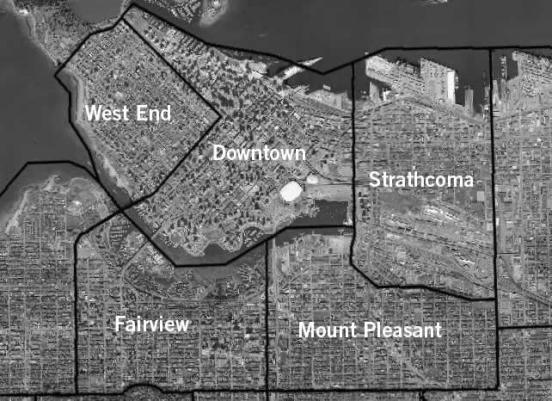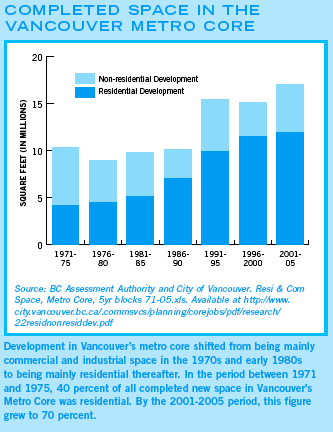Planners have heralded Vancouver, British Columbia as a vision for a sustainable urban utopia. Key to Vancouver's success in the 1990s was its "living first" development strategy, emphasizing a downtown that is not only a business district, but also a social and residential district. Under the "living first" plan, the city rezoned 8 million square feet from commercial space to residential use and began converting its waterfront railyards to housing. Although the development of housing was crucial to the revitalization of downtown Vancouver, the city is today questioning the impact of its housing boom, which has decreased space in its downtown core for new jobs.
Vancouver's "living first" policy resulted in an increase in the population of the downtown metropolitan core from 105,000 to 135,000 during the 1990s, double the rate of growth of the previous decade The metro core is an area slightly larger than the downtown peninsula and includes the Eastern Core and the south of False Creek area. The population growth is the result of rapid housing development. From 1996 to 2005, 24 million square feet of housing was built in the metro core. This is equivalent space to more than 49 of San Francisco's Transamerica Pyramid. The housing boom continues in downtown Vancouver, where there are currently 7,500 residential units under construction and an additional 2,700 units either approved or awaiting review.
 Source: VanMap, http://www.city.vancouver.bc.ca/
Source: VanMap, http://www.city.vancouver.bc.ca/
During the 1990s, Vancouver pursued a plan for downtown development that mixed social and residential uses with commercial space, but residential development has begun to drift into space reserved for new jobs.
Vancouver today has a successful Central Social District - a mix of office, residential, shopping and entertainment uses.
As housing exploded, the growth of employment and new office space was more modest. In the metropolitan core from 1996 to 2005, only 13,000 jobs were created and 8.7 million square feet of non-residential space was built (including retail, office, industrial, etc.). This resulted in a downtown that did not provide adequate jobs for its residents. Today, of the 78,000 employed residents in the metro core, 40 percent work elsewhere in the city or region.

Over this same time period, the city of Vancouver's share of regional jobs fell from 56 percent to 34 percent. While the city's share of regional population also declined, the drop was only from 39 percent to 27 percent. Of course, there are many other factors in this shifts, unrelated to land used for housing, as the Vancouver region - like virtually all metropolitan regions in North America - continues to suburbanize.
Housing development has begun to encroach on space reserved for offices. Analysts predict that Vancouver needs 10 million more square feet of office space than zoning currently permits, in order to accommodate projected job growth in the Downtown Peninsula area. Rents have reached new highs and office vacancy rates have already dropped below 5 percent, down from about 12 percent in 2005.
These trends led Vancouver to take a radical step. In 2005, city officials put a moratorium on new housing near the downtown business district. They hope that the moratorium will stem residential encroachment and encourage new office growth until a new plan for the future development of downtown Vancouver is completed.
San Francisco should heed the lesssons of the "living first" housing strategy in Vancouver. As we continue to pursue policies that prioritize residential development throughout our urban core, we must consider how this might affect our job base or the creation of additional office space.
Further, we should also learn from Vancouver's thoughtful approach to the impact of residential growth on office space, which has led that city to take a proactive look at its downtown zoning and growth. Vancouver's current Metropolitan Core Jobs and Economy Land Use Plan is providing the city both with valuable data on the historical trends that have shaped the current makeup of downtown and also with forecasts for its future. This information is allowing city officials to evaluate and change their zoning of downtown Vancouver to accommodate the appropriate mix of residential and commercial uses.
In the past, SPUR learned from Vancouver that allowing planners a certain creative space to operate resulted in "the interface between high-density housing and an enhanced public realm." We must also consider different lessons from Vancouver - whether there are some unintended consequences of a successful downtown residential boom.